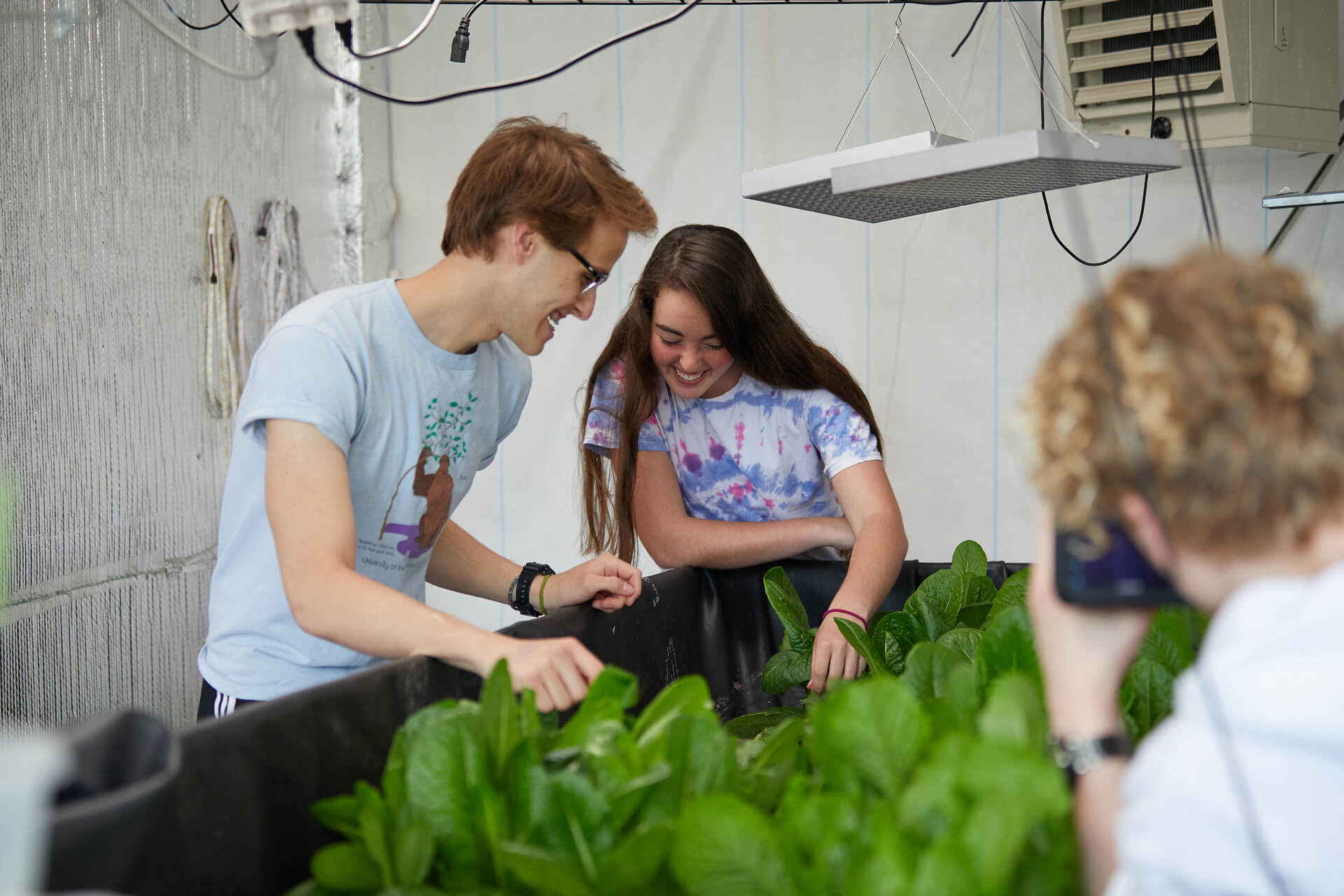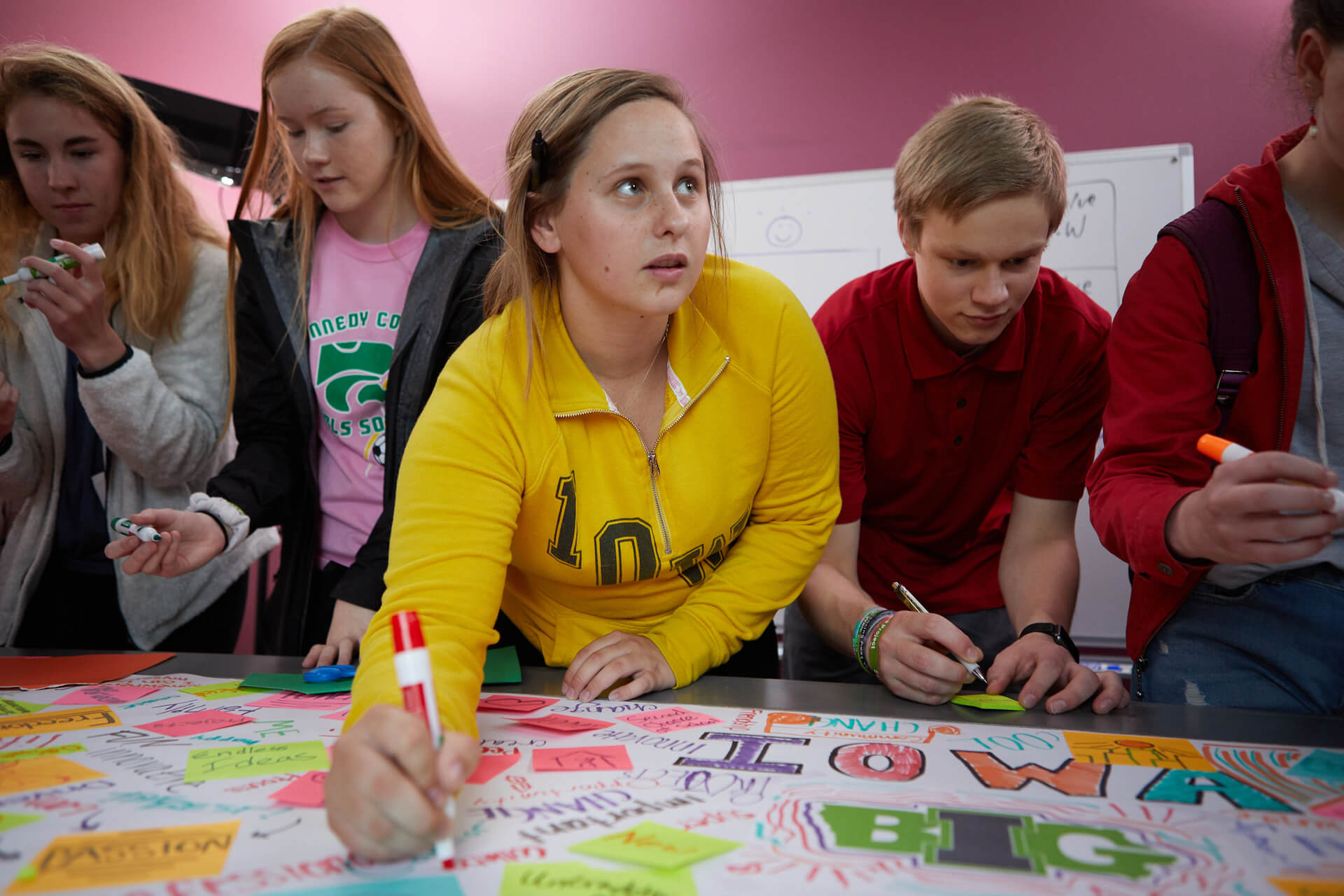Five Ways Educators Can Teach Collaborative Learning to Students
At Purdue Polytechnic High School, an XQ school in Indianapolis, Indiana, students work together to…

At Purdue Polytechnic High School, an XQ school in Indianapolis, Indiana, students work together to complete projects usually reserved for the professional world. Case in point: designing and building a hydroponic system and marketing their product in the community.
In this ambitious, complex project each student contributed a different piece according to their passions and interests. For instance, one student, Colten, served on the business team, focusing on keeping students on track, as well as developing marketing and sales strategies. Colten was so inspired he now plans to pursue a future as an entrepreneur.
This project embodies one of our core XQ Learner Outcomes: Generous Collaborators. Generous collaborators are self-aware team members who show up with enthusiasm and humility to work alongside others. By providing opportunities for collaborative learning, educators can prepare students to work with others to take on the complex challenges of the future.
What Is Collaborative Learning and Why Is It Important?
Collaborative learning is when students work together to solve problems, understand ideas, and create new products or solutions. It prepares students with the skills to communicate and work with others to drive their own learning, skills they’ll need after graduation whether they go straight to college or careers.
Experts Barbara Leigh Smith and Jean T. MacGregor explain that collaborative learning centers on students’ exploration and application of material—not just the teacher’s explanation. This is why collaborative learning is most effective when paired with a student-centered approach, where:
- Students have a say in what and how they learn.
- Students see each other as partners in learning.
- Teachers serve as guides and advisors, not the sole classroom leader.
Learning to collaborate is key for student success, in high school and beyond. The Center for Teaching Innovation at Cornell University identifies several research-backed benefits to collaborative learning, including:
- Development of high-level thinking, communication, self-management, and leadership skills.
- Increase in student retention.
- Increased exposure to and understanding of diverse perspectives.
- Increase in student self-esteem and responsibility.
- Preparation for real life social and employment situations.
To reap these benefits, collaborative learning needs to be rigorous and sustained. Drawing from examples from the XQ schools, we’ve outlined five ways educators can go beyond surface-level group work to teach true collaboration.
1. Demonstrate the Benefits of Collaboration
Too often, students see group work as a hoop to jump through. Some have negative stereotypes that not all students will work equally, or that grades will be awarded unfairly. Teachers should allow students an opportunity to address these concerns before the lesson begins. That way they can share their frustrations or fears and work with the teacher to find solutions, such as distribution of teamwork and fair grading practices. Listening to what the students are worried about can also help the teacher enhance their instructional strategies.
To engage deeply in collaboration, students need to understand how working with others will help them reach their goals. One way to show students the benefits of collaboration is through examples. Teachers can:
- Share the research on the benefits of collaboration with students, and connect those benefits to students’ own goals.
- Bring in examples of real-world collaboration in industries students are passionate about.
- Highlight exciting collaborative projects from other high schools (like Círculos students turning an alleyway into a vibrant public space, or New Harmony students creating an anthology of stories around climate change).

Teachers can also demonstrate the benefits of collaboration by asking students to evaluate their own learning. Before starting a collaborative project, they should help students set goals for the skills and knowledge they want to learn. These should combine academic goals as well as holistic ones, like communication, critical thinking, and creativity. At the end of the project, students can reflect on how working with others helped them grow as learners.
Grace, a student at Iowa BIG, an XQ school in Cedar Rapids, Iowa, described the intrinsic motivation that students experience when they’re fully invested in collaborative work:
“Just knowing the fact that, even if I don’t have important work that’s due at a certain time, I could still be working on other things that could benefit my group. Also, [I’ve learned] personal skills like managing, team-building, and accountability.”
– Iowa BIG Senior Grace
Extra: For more on helping students set and evaluate their progress on learning goals, explore our resources on competency-based education.
2. Assign Complex Learning Activities
Collaboration can feel unnecessary or artificial if the assignment is too easy or unengaging. Spark meaningful and engaged learning, another XQ design principle, by building collaborative projects around topics students care about, and are more ambitious than what they could do on their own.
Using elements of design thinking in projects provides teachers general structures for integrating complex tasks for student collaboration. They can gain skills by watching and working alongside their peers on coding or 3D printing. This lets them collaborate on developing ideas, sharing concepts, and reflecting on the work they’ve accomplished.
For instance, at Purdue Polytechnic High School, students collaborated on a weeks-long project to build an electric vehicle go-kart for racing. This interdisciplinary, multi-stage project was incredibly ambitious: students applied math and science to design the cart, then put in hours of work to build the cart by hand and test it out. They also tackled fundraising and marketing. To be successful, students had to work together—and in the end, they accomplished a tangible goal they were each passionate about.
This example showcases one key benefit of collaborative learning: positive interdependence. In working together to accomplish an ambitious task, students learn to rely on each other for success. This belief in the power of community is a hallmark of what it means to be a generous collaborator.
3. Make Collaboration Fun…Not Scary
As mentioned above, collaboration can be intimidating. Consider the classic fears of group work: being the only person working, or letting the whole group down. Teachers can set students up for success by allowing students a chance to air out their greivances when considering group work. From there, teachers and students can work together in identifyingclear expectations and guidelines for how groups should function.
As always, expectations and guidelines work best when they’re built in collaboration with students. To help support students as they come up with norms and procedures for collaborative work, ask questions like:
- How will students evaluate their own contributions to the group?
- What methods of communication work best for group members?
- How will the group divide work among members?
- How will members be accountable to one another?
Teachers can also take the pressure off collaboration by working to redefine failure in the classroom, so that students feel free to work together and take creative risks. For example, Iowa BIG educators have redefined failure for their students by getting rid of traditional grades. Instead, student project teams are evaluated based on lessons learned and skills gained. This approach frees students to have fun and be adventurous in their learning. Iowa BIG co-founder Trace Pickering explained, “Once kids recognize that we don’t punish failure, we begin to see that their fear melts away.”
4. Promote Discussion and Consensus
In collaborative learning, how students communicate with each other is as important as what they’re communicating about. Helping students build caring, trusting relationships with each other and with their teachers (another XQ design principle) sets the stage for students to feel comfortable working as a team.
A huge part of relationship building is giving students the opportunity to share who they are, and to hear from others in return. For example, at Círculos, an XQ school in Santa Ana, California, students start each day with a circle meeting—giving each studenta chance to share in a non-hierarchical format. These structured discussions give everyone a chance to speak honestly and listen deeply, key ingredients for relationship building and collaboration. See our in-depth guide on circle facilitation to try this in your classroom.
Teachers can also help guide group discussion and consensus building through providing specific prompts and structures for students to use throughout their collaborations. Educators can:
- Provide student groups with prompts to guide discussion at each stage of the assignment or project.
- Have groups provide regular reports on their progress and goals.
- Collect frequent feedback on group dynamics from individual students, and intervene if a group needs more communication support.
5. Organize Students Strategically To Help Them Learn Effectively
Through collaborating, students build self-awareness, stepping into their talents and learning from the strengths of others. Further, such self-awareness is a great opporunity to build asset mindsets in students, where students name the skills and strengths they bring to the team.
When grouping students for collaborative projects, teachers should consider the unique strengths each student brings to the group, and what students might be able to learn from each other. To build groups that maximize students’ opportunities for learning:
- Group students with peers with whom they might not otherwise work.
- Create multiple roles within the group that require different skill sets.
- Allow students to self-select into roles they feel confident about.
This approach embodies asset-based mindsets, where students see themselves as learners through the lens of their strengths. In this video from PSI High, an XQ school in Sanford, Florida, teacher Angela Daniel describes how naming students’ strengths can transform their confidence as learners.
Setting up students to learn from one another also gives them an opportunity to step into leadership roles in teaching or managing their peers. These experiences give students the confidence they need to pursue leadership roles outside of the classroom. And, on the flip side, students learn to recognize areas in which they need support, and can experience the value of working with other people who have different strengths and perspectives.
Through collaborative learning, students learn how to tackle challenges through community. They gain the leadership and self awareness they’ll need to work with others to tackle pressing challenges.
Read more on how you can support students for future success.
- Fostering Stronger Teacher-Student Collaboration
- Want a Strong School Culture? Focus on Coherent Leadership
Photo at top from Iowa Big by Chris Chandler









